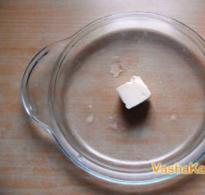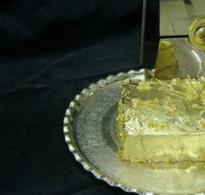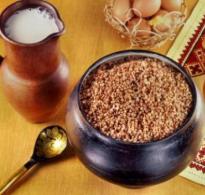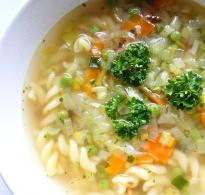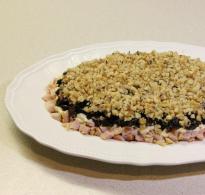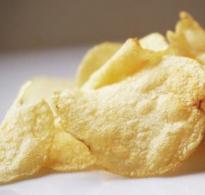Oil production technology. Oil classification, methods and technological schemes of production
Butter is a high-calorie product with a pleasant taste and aroma. It is produced from the cream of cow or buffalo milk.
There are two oil production method:
- churning of medium-fat cream (35–38%) in oil producers;
- conversion of high-fat cream (82.5–83%) to butter.
The milk received by the organization is separated in order to obtain cream.
Technological scheme of oil production churning method is as follows: sorting and preparation of cream -> pasteurization -> cooling and ripening of cream -> churning of cream into butter grains –» washing and mechanical processing of butter grains –> packaging and packaging of butter.
Cream is sorted by organoleptic characteristics and acidity, normalized by fat content and pasteurized at a temperature of +85…95 °C.
After pasteurization, the cream is immediately chilled. At a cream temperature of +1 ... 3 ° C - the duration of ripening in summer is 2 hours, in winter - 1 hour, at a cream temperature of +4 ... 8 ° C - the duration of ripening in summer is 4 hours, in winter - 2 hours.
 According to the given production mode, part of the cream is used for churning (to obtain sweet butter), part for maturation, i.e. cooling of cream with added starter cultures to the fermentation temperature (for sour-butter).
According to the given production mode, part of the cream is used for churning (to obtain sweet butter), part for maturation, i.e. cooling of cream with added starter cultures to the fermentation temperature (for sour-butter).
The fermentation of the cream, depending on the temperature, lasts 14–16 hours. In the first 3 hours, the cream is stirred every hour, and then they are left alone. The end of fermentation is determined by the increase in acidity up to 65 °T in summer and 80–85 °T in winter.
Long-term pasteurization baths are also used for cooling and maturation. With the rapid cooling of fermented cream to +5 ... 6 ° C, the ripening process can be reduced to 6-8 hours. During the ripening process, 40-50% of milk fat hardens.
Used to make oil batch butter makers, in which cream is churned, i.e. obtaining oil grain and buttermilk, processing the resulting oil.
Churning under correctly chosen conditions should continue in oil refineries for 50–70 minutes and end when an oil grain of 3–5 mm is obtained. The size of the butter grain determines its ability to retain buttermilk.
In order to increase the stability and lengthen the shelf life of the oil, the resulting oil grain is subjected to a double washing with water, after removing the buttermilk from the oil maker. The temperature of the wash water should be equal to the temperature of the buttermilk, and during the second wash it should be 1–2 °C lower.
The purpose of oil processing is to obtain a homogeneous consistency with the required moisture content, evenly distributed in the oil. The degree of dispersion of moisture in the oil depends on the duration of the revolutions of the oil maker. The moisture content of the oil must not exceed 14%. The oil should look dry.
 Work more efficiently continuous oil makers. Cream with a fat content of 38–42% is churned in a butter maker. Ripened cream enters the regulating receiving tank, and from there into the beater cylinder, which is a stainless steel drum with a jacket and cold water circulation. A stirrer rotates at high speed in the cylinder, which whips the cream into a butter grain in 20-30 seconds.
Work more efficiently continuous oil makers. Cream with a fat content of 38–42% is churned in a butter maker. Ripened cream enters the regulating receiving tank, and from there into the beater cylinder, which is a stainless steel drum with a jacket and cold water circulation. A stirrer rotates at high speed in the cylinder, which whips the cream into a butter grain in 20-30 seconds.
Butter grain, together with buttermilk, enters a screw-type processing cylinder, consisting of several chambers: for separating buttermilk, for washing and processing butter.
In the first chamber, the oil grain is separated from the buttermilk using augers, which flows through the filter into the buttermilk outlet siphon, then the grain is sent to the oil washing chamber, where it is washed with a jet of cold water (+3 ... 5 ° C) supplied under high pressure, and at the same time loosened.
The oil is then pushed by augers into a vacuum chamber where the water is removed. The finished oil in the form of a continuous rectangular belt is pushed out of the oil maker by a screw through a conical nozzle and sent to the machine for packing into boxes or packs. In the manufacture of amateur oil, flushing is not carried out.
In-line method butter is produced on three main devices– pasteurizer, separator and oil former:

Installation diagram for butter production
1 - tank with a jacket and a stirrer; 2 - dispersant; 3 - pump; 4 - tubular pasteurizer; 5 - three-cylinder oil former; 6 - oil filling machine
First, cream with a 35–40% fat content is produced from fresh milk. Then they are pasteurized at a temperature of +85 ... 86 ° C and above in a centrifugal pasteurizer and sent to a separator to obtain high-fat cream with a fat content of 83%.
The resulting high-fat cream is an emulsion of fat in water and does not have the structure of butter. To give such a structure, they are processed in special apparatus - oil formers.
Butter today is one of the most common and versatile food products that can often be seen in the refrigerator of our compatriots. Accordingly, it is safe to say that the demand for it is very high. In this regard, the production of butter can be an excellent business idea, even despite the rather high competitive activity. Indeed, a truly high-quality and tasty product at an affordable price will always find its consumer. About how to organize such a business, we propose to talk further.
Registration of a legal entity
First of all, you should decide on the scale on which you will produce butter. So, you can organize a very small business, in which your family members are employed.
Accordingly, in this case, it will be enough to register yourself as an individual entrepreneur with a simplified taxation system. If you have sufficient start-up capital or plan to use the investor's funds, then it makes sense to open an LLC.
Permits
Butter is included in the list of goods subject to mandatory certification. Therefore, without such a document, it will not be possible to start production. In addition, since you plan to manufacture food, you will need to bring the workshop and premises for storing raw materials and finished goods in accordance with certain requirements of the SES.

Butter production technology
The manufacture of this food product is possible in two ways: the method of churning cream and the method of converting heavy cream. We invite you to learn more about each option. But first it should be noted that the first two stages - acceptance and separation of milk - are the same for both methods.
Then there is a process of pasteurization of cream with a fat content of 35 to 45%, during which extraneous microflora is destroyed and deodorization is carried out. The subsequent stages are already radically different depending on the production method.
Whipping cream method
Pasteurized cream is cooled and kept for some time at a temperature of 2-8 degrees Celsius. This is necessary for the product to "ripen". Moreover, the lower the temperature, the faster this process.
After that, the cream is placed in butter drums, which are rotating wooden barrels or metal cylinders. As a result of the impact of mechanical shocks, an oil grain is born, which consists of crystallized particles of fat contained in milk. After that, the knocking process is stopped.
Then the oil grain is washed once or twice. To increase the stability of the oil during storage, calcined salt is added to it. After that, the mass is passed through the squeezing rollers, as a result of which a dense homogeneous layer is formed, which remains only to be packaged and packaged. It should be noted that the technology for the production of sour cream butter is no different from the stages described above, except that after pasteurization it is necessary to ferment.

Heavy cream conversion method
This method of manufacturing the product is based on the process of thermomechanical processing of raw materials. At its first stage, cream with a high fat content is obtained, which is then sent to the butter former, where they acquire the structure characteristic of butter. Without going into theoretical details, it should be noted that the consistency of such a product differs significantly from that produced by the churning method.
To complete the process of making butter, it must go through a maturation process. To do this, it is kept for several days at a temperature of 12-16 degrees Celsius. It should be noted that if the finished product “spreads” at room temperature, it means that the temperature regime was violated at the final stage of its production process. However, this does not diminish its nutritional value.

Butter production equipment
Since most businessmen organize the manufacture of this product on an industrial scale, consider what you need to purchase to implement the fat cream conversion method:
Separators (they separate cream with medium fat content into high-fat cream) - the cost is from 80 to 200 thousand rubles.
Vacuum deodorizers (remove foreign tastes and odors) - 600 thousand rubles.
Normalization baths (set the required mass fraction of moisture) - 150 thousand rubles.
Bath for long-term pasteurization - 150-800 thousand rubles.
Cylindrical and lamellar butter-formers (make butter from cream). The price range of this equipment is very wide and depends on the performance (from 150 thousand rubles to 20 million rubles).
Since oil is an everyday product for many people, it is therefore important what is butter production technology. Butter is a rather valuable product where milk fat is concentrated. It must necessarily satisfy certain requirements that relate to taste, product structure, consistency, and durability.
First of all, the quality of the butter produced depends on the quality of the raw materials used, where the butter production technology, compliance with all necessary sanitary regimes and its storage conditions are also of great importance.
Production technology regarding the manufacture of butter:
The first method involves the conversion of high-fat cream.
The second method is to churn cream, where the allowable percentage of fat should be 30-35 percent.

The second method is used in the production of small volumes of traditional butter among urban dairies.
Butter is made by the conversion method, which is used in all other types, which also includes varieties with fillers of any volume.
Technology for the production and release of butter using the churning method.
At the entrance, the product presents: MJ cream with 35 percent.
At the output, the product is: MJ butter, where the percentage of fat content can be in the range of 61-82.5 percent.
Butter production - main operations
Any factory for the production of butter implies a production process that is based on the following stages:
1.
Milk intake.
2.
Next, the separation of whole milk takes place, after which cream is obtained.
3.
Normalization of the resulting cream for fat. Removal of possible odors and tastes.
4.
Pasteurization of cream at a temperature of 85 degrees without exposure.
5.
This is followed by low-temperature preparation of cream.
6.
Whipping cream.
The production of butter involves the use of various structures on which the process of churning cream takes place, butter grains are washed, salting, and mechanical processing of butter is also carried out. For the implementation of these processes is used equipment that is necessary for the production of various butter.

As for the cream, before they enter the butter maker, they are filtered. The churn is filled with 50 percent cream of its total volume. The duration of whipping takes from forty to sixty minutes. The churning process ends after an oil grain of 3-5 mm in size is obtained.
7. Washing the oil grain.
Thanks to this process, butter has a greater shelf life. So, in the process of washing, the remains of buttermilk, which acts as a nutrient medium for many microorganisms, are removed. Wash water must be of potable quality.
8. Salting oil.
The production of butter includes a process such as salting the butter, due to which the butter has a high storage stability. The boiled salt is sifted and also calcined.
9. Mechanical processing of oil grains.
This procedure is carried out in order to combine disparate grains into a single layer of oil. Rollers or screws are used for mechanical processing of oil in oil producers.
10. Packaging of the product is carried out in parchment, corrugated boxes, as well as in cached foil.
Thermostating implies a certain process, where the production of butter in the first days (up to 5 days), after the butter is produced, it must be kept at temperatures up to 15 degrees. This is done in order to create favorable conditions for the final process of crystallization of the milk fat itself, in order to improve the structure and physical properties of the oil.
In the process of making butter, the technology of butter production must be maintained.
Butter is a product that is constantly present in the refrigerators of most Russians. Polls show that a butter and cheese sandwich is a favorite breakfast for both children and adults. Butter emphasizes or, on the contrary, softens the taste: for example, a sandwich with red caviar is simply unthinkable without butter.
Few people know that this product has an ancient history: for the first time, butter was obtained in India about 3000 years ago. But the Italians became the first developers of the industrial method for the production of butter. It was they who, at the beginning of the 19th century, launched the first mechanical units, with the help of which a high-fat product was produced, which became the prototype of butter in its modern conception. In the middle of the 19th century, butter was also successfully produced in Russia, churning it from fresh or fermented cream, and Vologda butter rightfully became the pride of domestic butter makers.
The quality of a product cannot depend on only one parameter: everything is important in the production of butter: the quality of raw materials, the method of manufacture, and strict adherence to the parameters of the technological process. Each of these factors largely determines the quality characteristics of the finished oil.
For the production of butter, both first and second grade milk can be used. Yes, do not be surprised: since the time of Bulgakov (“sturgeon can only be the first freshness”), little has changed. In European countries, the concept of “second-class milk” is absent at all, while in Russia, milk, which has obvious defects in taste and texture, is used very actively for the production of butter, which, oddly enough, is allowed by GOST.
Butter production is a complex multi-stage technological process, the ultimate goal of which is the concentration and isolation of milk fat. On an industrial scale, butter is produced in two ways: by mechanical churning of cream with a fat content of 35-40% or by converting high-fat cream with a fat content of 70-85%. When churning cream, a higher quality butter is obtained, which has better organoleptic and structural characteristics, but this method, alas, is inefficient. That is why for more than half a century, 90% of butter has been produced by converting high-fat cream.
Receiving milk and separating it are stages that are the same for all methods of butter production. After separation, cream containing from 35 to 45% fat is subjected to pasteurization, during which extraneous microflora is killed and deodorization is carried out (removal of extraneous "feed" flavors). The subsequent technological steps differ significantly depending on how butter is produced.
Whipping cream method
Before you place the cream in the butter drums, they must be cooled and kept at a temperature of 2 to 8 ° C. During this time, the cream ripens, its viscosity increases, microscopic fat globules agglomerate, which subsequently become centers of fat crystallization. The lower the temperature, the faster the cream "ripens", and mechanical stirring allows you to further speed up the process.
Whipping cream is carried out in butter makers, which are rotating metal cylinders or wooden barrels. Under the action of mechanical shocks, an oil grain is born, consisting of crystallized particles of milk fat. After the buttermilk begins to splatter, the churning process stops and the butter grain is washed once or twice. To increase the stability of the oil during storage, it is salted with extra calcined salt. Further, the oil mass is passed through the squeezing rollers, after which a dense homogeneous layer is formed, ready for packing, packaging and storage. It should be noted that the production of butter from sour cream is possible only by churning.
High fat cream conversion
The principle of the method is based on the conversion of an oil-in-water emulsion (cream) into a water-in-oil emulsion (butter) using thermomechanical treatment. At the first stage, high-fat cream with a fat content of 72.5% or 82.5% is obtained, which, passing through the butter former, acquire a structure characteristic of butter. Without delving into the wilds of the theoretical foundations of fat crystallization, we can say that the oil obtained in this way has a completely different structure than that produced by churning cream. Before the final readiness, it must go through the stage of maturation - holding for several days at a temperature of 12-16 ° C in order to complete the crystallization process. Probably, many paid attention that sometimes butter "spreads" at room temperature - this is a consequence of a violation of the temperature regime at the stage of cream transformation or butter maturation. At the same time, the nutritional value does not decrease at all, and the consistency defect is not a rejection sign.
Regardless of how butter is produced, its structure must be uniform and dense. At a temperature of 12-14°C, the oil should not crumble; on the cut, the appearance of the smallest drops of water is allowed.
In accordance with GOST, several varieties of butter are produced in Russia (from fresh or fermented cream, with different fat content, salted or unsalted). Each consumer can choose the product that best suits their own food preferences.
The most common technologies for the production of butter:
1. Method of churning cream 30...35% fat.
2. Method for converting high-fat cream.
The churning method is used to produce small volumes of traditional butter in urban dairies.
Butter production by transformation method - for all other types of butter, including varieties with fillers, in any volume. Starting from the 50s and up to the present day, the method of converting HPS has replaced all other methods of oil production by 90%.
Technology for the production of butter by the churning method.
Input product: MJ cream 35%
Output product: butter MJ 61...82.5%
Basic operations of butter production:
1. Reception of milk
2. Separation of whole milk, obtaining cream
3. Normalization of cream for fat. Correction of defects - removal of smacks and smells (washing, deodorization)
4. Pasteurization of cream at t 85 °C without exposure.
5. Low-temperature preparation of cream (physical ripening). Immediately after pasteurization, the cream is quickly cooled to a temperature of 4-6 ° C and kept for 7-15 hours.
6. Whipping cream
To obtain butter, butter makers of various designs are used, where cream is churned, butter grains are washed, salted, and butter is mechanically processed. The cream is filtered before being fed into the butter maker. The churn is filled with cream for 50% of the total geometric volume of the container. The drum rotation speed is usually 30-40 rpm. The initial t of knocking down is 8-14 ° C. The duration of knocking down is 40-60 minutes. In the process of churning, agglomeration of fat globules occurs. The churning ends when oil grains with a size of 3-5 mm and buttermilk are obtained.
7. Oil grain washing
Washing the oil grain increases its storage stability. The washing process removes the remains of buttermilk, which is a breeding ground for microorganisms. In addition, washing allows you to adjust the mass fraction of moisture in the finished product. Wash water must be of potable quality. Cold water is poured into the churn after draining the buttermilk, while the churn is running at a speed of 10 rpm. Washing is carried out twice
8. Oil salting
Salting oil increases the stability of the oil during storage. Salt content 0.8-1.2%. Salt is sieved and calcined. Dry salt is added to the oil grain.
9. Machining oil grain
It is carried out in order to combine disparate grains into a layer of oil that has a uniform consistency and the required moisture content. Mechanical processing of oil is carried out using rollers or screws in continuous oil makers or using blades in rollerless oil makers.
10. Product packaging Produced in corrugated boxes, parchment or cached foil and other containers.
Butter production technology by converting high-fat cream.
Basic operations of butter production:
1. Reception of milk
2. Getting cream. Cream is normalized for fat. Correction of defects is carried out - removal of tastes and odors (washing, deodorization).
3. Cream pasteurization. At t 85 °С without exposure.
4. Cream separation. The cream is separated to obtain a high-fat cream with a fat content corresponding to that of the butter. It is carried out on high-fat cream separators.
5. Normalization of high-fat cream
It is carried out in containers by adding buttermilk or pasteurized milk to high-fat cream, if the moisture content in the cream is lower than required; in case of excessive moisture content, HFS is normalized with benign milk fat, followed by its emulsification (circulation with a c / w pump). The maximum moisture content in the cream is 15.8%.
6. Temperature control
Aging cream to acquire a richer taste and smell. It is usually carried out in normalization baths of the VN-600 type.
7. Thermomechanical processing of high-fat cream
In the process of t/m treatment of HFA, the conditions necessary for the crystallization of milk fat triglycerides and phase change are created. The fat-in-water emulsion is converted into a water-in-fat emulsion under the action of mechanical action and temperature.
Processing in a cylindrical oil former
Oil former TOM-2M consists of three cylinders; in each of them, a displacing drum rotates, on which two flat knives are fixed, which remove the hardened layer of HFA from the inner surface of the cylinder.
Brine and ice water are supplied to the cylinder jackets.
VZhS from the normalization bath is fed by a pump (rotary or gear) into the lower cylinder of the oil former, cooled and forced out into the second and then the third cylinders. In the second cylinder, the crystallization zone begins: in the entire volume of cream, mass crystallization of triglycerides begins, which is accompanied by a phase change. The mixing time is 140-160 seconds in winter and 180-200 seconds in summer. The operating mode of the oil-forming agent is controlled by the temperature of the VZhS. It is recommended that at t of 60-70 °С entering the VZhS apparatus, maintain t at the outlet of the oil former 13-16 °С.
Processing in a plate oil former
It consists of a cooling plate package and a special chamber for crystallization and mechanical processing of the oil. The brine moves between the plates. Knives rotate in the gap between the plates, with the help of which more vigorous mixing and more intensive cooling of the cream is achieved than in a cylindrical butter former. A paddle stirrer rotates inside the crystallization chamber. The adjustment of the oil formation process is carried out by changing the rate of cooling of the VZhS. It is recommended to cool the cream at a speed of several tens of degrees per minute to t 15-20°C. Oil packaging. It is produced in 20 kg boxes, parchment (briquettes of 250 grams) on an APM-type packing machine or in any convenient small container.
8. Temperature control
In the first 3-5 days after production, the oil is kept at t 5-15 ° C in order to create favorable conditions for the completion of the milk fat crystallization process, improving the structure and physical properties of the oil.
Basic assortment of butter
1. Sweet cream butter with a mass fraction of fat (hereinafter MJ) 82.5%.
2. Butter sweet creamy salty.
3. Butter Vologda (from cream subjected to high-temperature processing).
4. Sour cream butter (from fermented cream).
5. Cheese butter (from whey cream).
6. Amateur oil with MJ 78.0%.
7. Peasant oil with MJ 72.5%.
8. Sandwich butter with MJ 61.5%.
9. Butter with fillers (coffee, cocoa, fruits, honey, etc.).
10. Combined oil, with the addition of vegetable fats.
11. Melted butter.
12. Oil-like products (spreads) with MJ 20....50% (light oils)

